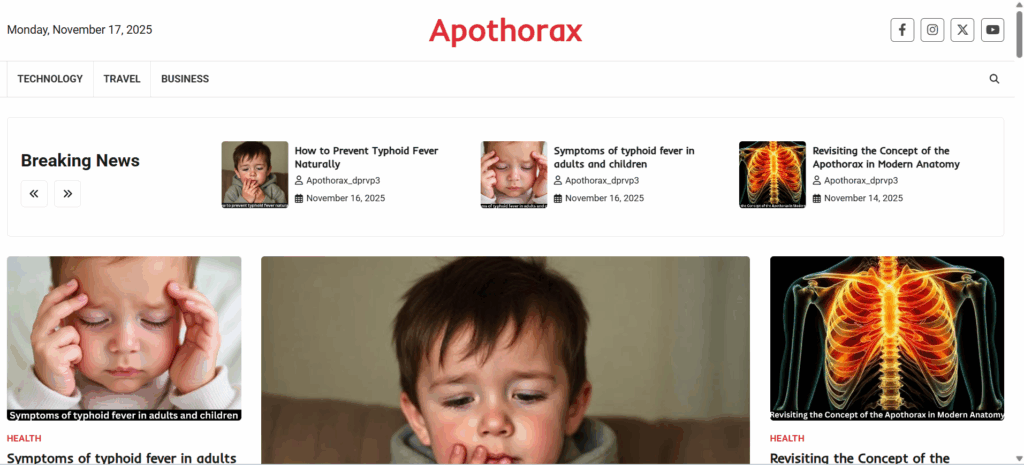If you’re studying for a biology exam, preparing for NEET, or trying to understand anatomy more clearly, terms like thorax and apothorax can feel unnecessarily confusing. Both sound similar, both relate to the chest, and both include vital organs. So what makes them different?
Let’s break it down in a simple, student-friendly way.
Why Students Confuse These Two Terms
Different textbooks use different terminology, and the apothorax isn’t referenced as commonly as the thorax. This inconsistency leads to confusion.
Importance of Understanding Thoracic Divisions
Knowing the difference helps you easily visualize organ placement, understand chest anatomy, and answer exam questions confidently.
What Is the Thorax?
Basic Definition
The thorax is the entire chest region of the human body, located between the neck and the abdomen.
Main Components
- Ribs
- Sternum
- Thoracic vertebrae
- Diaphragm
- Heart
- Lungs
- Major blood vessels
Thoracic Cavity Overview
The thoracic cavity houses the vital organs responsible for breathing and circulation.
What Is the Apothorax?
Clear Definition
The apothorax refers to the upper portion of the thorax where the heart, lungs, and major vessels are situated.
Why the Term Is Less Common in Textbooks
Some curriculums use simplified terminology and skip regional distinctions like apothorax. However, many advanced anatomy resources still acknowledge it.
Student-Friendly Explanation
Think of the thorax as a big storage cabinet. The apothorax is its top shelf that stores the most important items—your heart and lungs.
Key Differences Between Apothorax and Thorax
Anatomical Distinction
- Thorax: Entire chest cavity
- Apothorax: A section within the thorax
Structural Differences
- Thorax includes ribs, sternum, and diaphragm.
- Apothorax includes thoracic organs only.
Functional Differences
- Thorax protects and supports the chest.
- Apothorax handles breathing and circulation.
Table Comparison
| Feature | Thorax | Apothorax |
|---|---|---|
| Coverage | Entire chest region | Upper thoracic region |
| Boundaries | Neck → Diaphragm | Ribs → Diaphragm |
| Organs | Heart, lungs, trachea, etc. | Heart, lungs, major vessels |
| Function | Support, protection | Respiration, circulation |
Location of the Thorax
Superior and Inferior Boundaries
- Superior: Base of the neck
- Inferior: Diaphragm
Lateral and Posterior Boundaries
- Lateral: Ribs
- Posterior: Spine
Internal Organs
Heart, lungs, bronchi, esophagus, thymus.
Location of the Apothorax
Upper Thoracic Region
Found in the upper chest area enclosed by ribs.
Relationship to the Ribcage
Protected fully by the bony ribcage.
Diaphragm as the Lower Border
Forms the lower boundary, separating it from the abdomen.
Organs Present in Each Region
Organs of the Thorax
- Heart
- Lungs
- Thymus
- Trachea
- Esophagus
Organs of the Apothorax
- Heart
- Lungs
- Aorta
- Pulmonary trunk
- Vena cava
Shared and Unique Structures
The apothorax holds the core vital organs of the thorax.
Role of Each Region in Breathing
Thorax in Respiratory Movements
Expands and contracts during breathing.
Apothorax in Lung Expansion
Allows lung tissues to expand during inhalation.
Inspiration vs Expiration
- Inhalation: Chest expands
- Exhalation: Chest relaxes
Circulatory Functions
Heart’s Placement
Central pumping organ located in the apothorax.
Major Blood Vessels
Aorta, pulmonary trunk, vena cava ensure efficient blood flow.
Thoracic Cavity Pressure Changes
Breathing alters pressure and impacts circulation.
Why the Apothorax Matters in Medical Studies
Simplifies Thoracic Anatomy
Breaking the thorax into regions makes learning easier.
Important for Clinical Interpretation
Helps doctors identify where issues originate.
Relevant in Board Exams & Medical Entrance Tests
Boundary-based questions frequently appear.
Common Misconceptions Students Have
Apothorax Is Not Another Name for Thorax
It’s a smaller region inside the thorax.
It’s Not a Separate Cavity
It is a division, not an independent cavity.
It Doesn’t Include Abdominal Organs
Those lie below the diaphragm.
Clinical Conditions Affecting Each Region
Thoracic Conditions
- Pneumothorax
- Rib fractures
Apothorax-Related Conditions
- Pneumonia
- Pleurisy
Cardiac Conditions
- Pericarditis
- Heart infections
Imaging Differences
What X-rays Show
Basic lung and heart shadows.
CT and MRI Viewpoints
Show detailed sectional anatomy.
How Doctors Distinguish These Regions
By interpreting bone, organ, and cavity structures.
Study Tips for Students
Memory Tricks
Use the mnemonic “Top = Apo” (Apothorax is the top region).
How to Draw the Regions
Practice drawing the ribcage and diaphragm first.
What to Focus on for Exams
- Boundaries
- Functions
- Organ placement
Summary Chart of Differences
A quick comparison:
- Thorax = whole chest
- Apothorax = upper thorax
- Thorax protects
- Apothorax performs vital functions
Conclusion
Understanding the difference between the apothorax and thorax helps you master human anatomy in a clear, logical way. The thorax is the protective chest cage, while the apothorax houses the essential organs responsible for breathing and circulation. When you see them as interconnected parts of the same system, everything makes more sense—from exam diagrams to clinical applications.
FAQs
1. Is the apothorax a separate cavity?
No, it’s a subdivision of the thorax.
2. Which organs are in the apothorax?
Heart, lungs, aorta, pulmonary arteries, vena cava.
3. Why is this difference important?
It helps in understanding thoracic anatomy and answering exam questions.
4. Does the apothorax include abdominal organs?
No, those lie below the diaphragm.
5. Is the apothorax used commonly in modern anatomy?
It appears in some advanced or older texts but not all.

